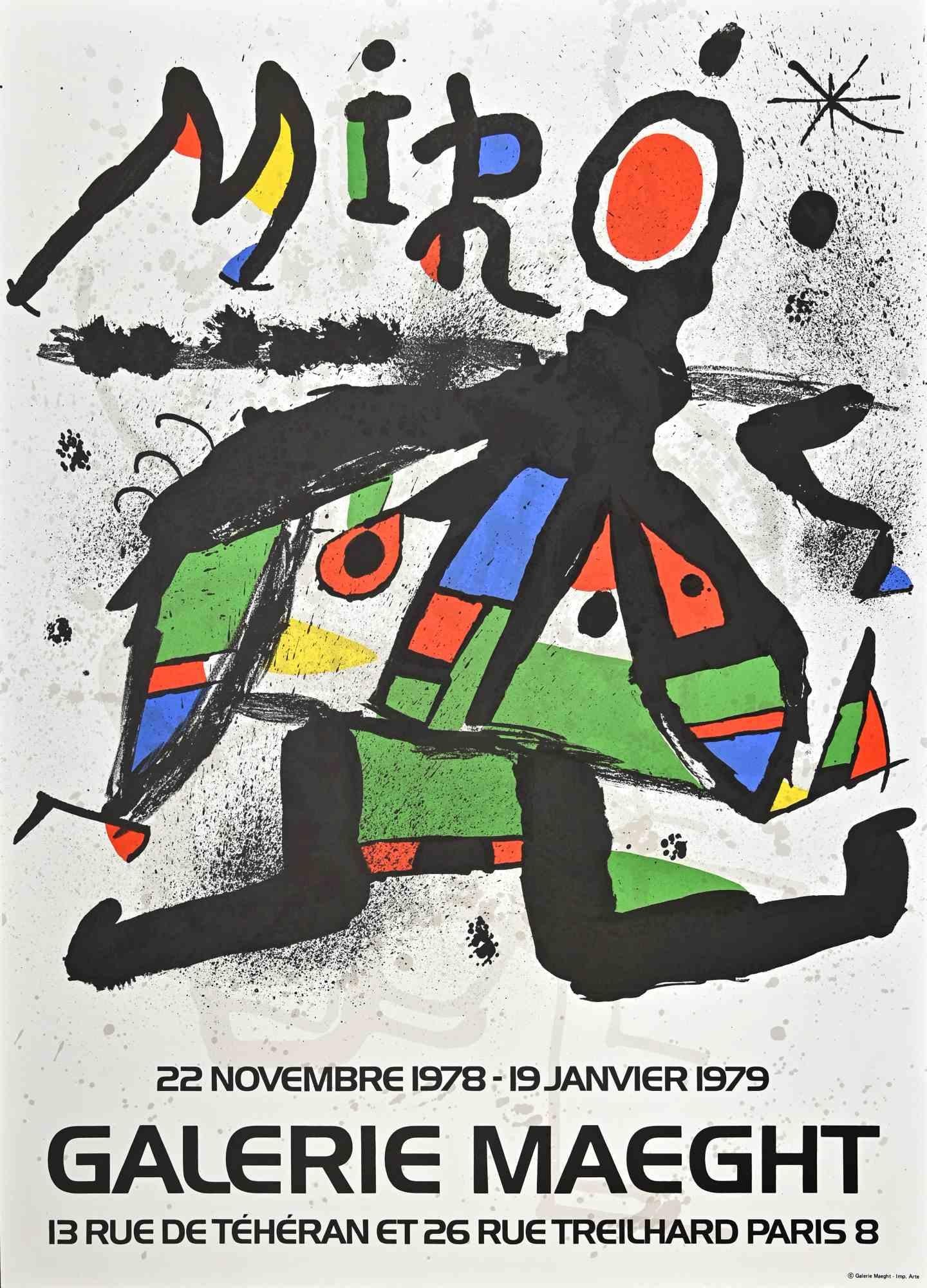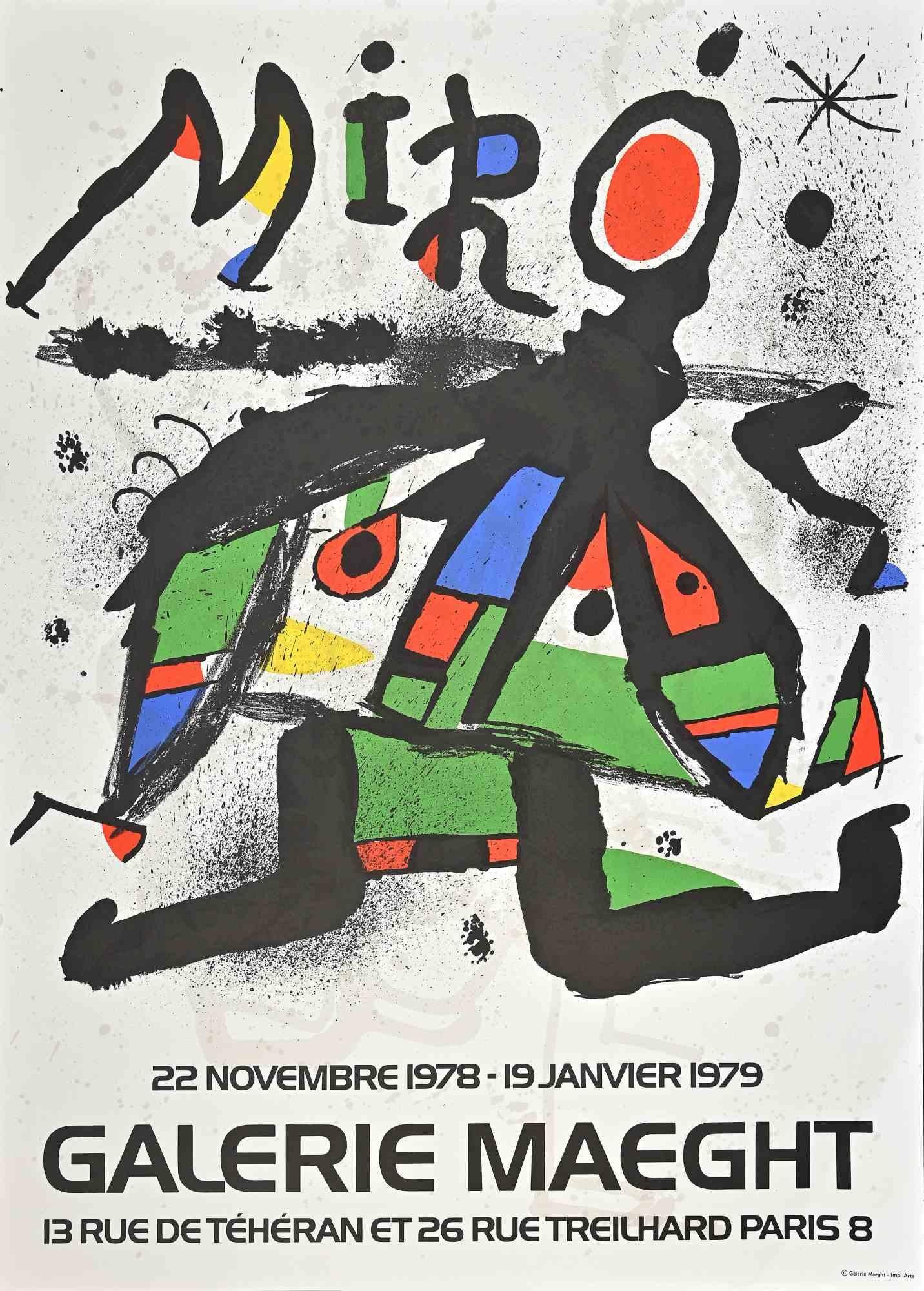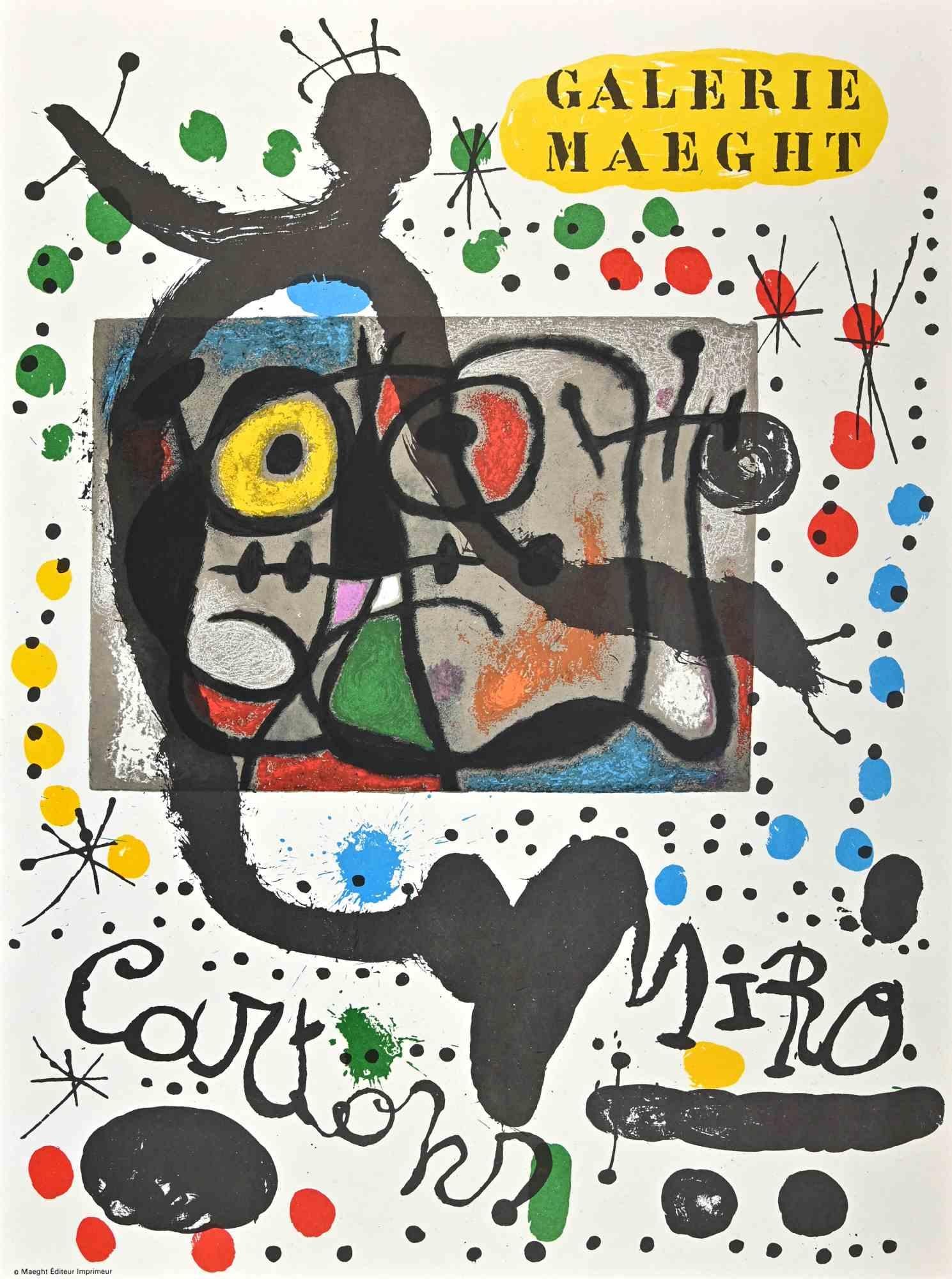Items Similar to Woman - Offset and Lithograph - 1983
Want more images or videos?
Request additional images or videos from the seller
1 of 6
Woman - Offset and Lithograph - 19831983
1983
About the Item
Woman is an offset and lithograph print realized on Fabriano Paper after a drawing by Willem De Kooning of 1983.
The print suite was realized in a limited edition of 2500, and curated by Xavier Fourcade.
Very Good conditions.
Willem de Kooning (Rotterdam, April 24, 1904 - New York, March 19, 1997) was a Dutch-born American painter and sculptor. From 1926 he moved to the United States and during the tremendous years of the economic crisis he created frescoes on commission from the WPA Federal Art Project. During the Second World War, he became part of the group of abstract artists, formed around the numerous European emigrant painters. In 1948, with his first solo exhibition at the Egan Gallery, he established himself as one of the most prominent exponents of abstract expressionism. his artistic language matures in the context of abstract expressionism, becoming one of its most significant representatives. His canvases are the representation of a deforming and violent vision that abstracts external reality. Adherence to a realist matrix, however also found in those works where the informal appears absolute. In his artworks, the chaotic and violent lines tend to lose any definition of the structure, and new balances of relationships and harmonies of rhythm are born, constants through which he recovers the form and attributes new values to it. To this vision full of contradictions belongs the series of female images of the fifties and sixties, of dramatic and cruel reality, a constant theme of the artist.
- Creation Year:1983
- Dimensions:Height: 20.48 in (52 cm)Width: 14.57 in (37 cm)Depth: 0.04 in (1 mm)
- Medium:
- Movement & Style:
- After:Willem de Kooning (1904-1997, American, Dutch)
- Period:
- Condition:Insurance may be requested by customers as additional service, contact us for more information.
- Gallery Location:Roma, IT
- Reference Number:Seller: T-1359701stDibs: LU650311330362
About the Seller
4.9
Platinum Seller
These expertly vetted sellers are 1stDibs' most experienced sellers and are rated highest by our customers.
1stDibs seller since 2017
6,717 sales on 1stDibs
Typical response time: 2 hours
- ShippingRetrieving quote...Ships From: Rome, Italy
- Return PolicyA return for this item may be initiated within 14 days of delivery.
Auctions on 1stDibs
Our timed auctions are an opportunity to bid on extraordinary design. We do not charge a Buyer's Premium and shipping is facilitated by 1stDibs and/or the seller. Plus, all auction purchases are covered by our comprehensive Buyer Protection. Learn More
More From This SellerView All
- Vintage Exhibition Poster at Galerie Maeght - Offset and Lithograph - 1968By Joan MiróLocated in Roma, ITMirò - Fondation Maeght is an original artwork realized after Joan Miró. Offset and Lithograph. The artwork was realized in the occasion of the exhibition dedicated to the graphic ...Category
1960s Surrealist Abstract Prints
MaterialsLithograph, Offset
- Vintage Poster Modern Art Museum - 1977Located in Roma, ITVintage Poster Modern Art Museum is a vintage Lithograph and Offset poster realized after Joan Mirò (1893-1983) in 1977. Good conditions. Joan Miró (20 April 1893 – 25 December 198...Category
1970s Surrealist Abstract Prints
MaterialsOffset, Lithograph
- Vintage Poster - Exhibition at Galerie Maeght - 1978Located in Roma, ITVintage Poster Exhibition Galerie Maeght is a vintage Lithograph and Offset poster realized after Joan Mirò (1893-1983) in 1978. Good conditions. Joan Miró i Ferrà (20 April 1893 –...Category
1970s Surrealist Abstract Prints
MaterialsOffset, Lithograph
- Vintage Poster Exhibition Galerie Maeght-Lithograph/Offset after J. Mirò-1970sBy (after) Joan MiróLocated in Roma, ITVintage Poster Exhibition Galerie Maeght is a vintage Lithograph and Offset poster realized after Joan Mirò (1893-1983) in the 1970s. Good conditions. Joan Miró i Ferrà (20 April 1...Category
1970s Surrealist Abstract Prints
MaterialsLithograph, Offset
- Vintage Poster Exhibition Galerie Maeght-Lithograph/Offset after J. Mirò-1978By (after) Joan MiróLocated in Roma, ITVintage Poster Exhibition Galerie Maeght is a vintage Lithograph and Offset poster realized after Joan Mirò (1893-1983) in 1978. Good conditions. Joan Miró i Ferrà (20 April 1893 –...Category
1970s Surrealist Abstract Prints
MaterialsLithograph, Offset
- Vintage Poster Exhibition Galerie Maeght after Joan Mirò - 1978By (after) Joan MiróLocated in Roma, ITAbstract Composition is a vintage Lithograph and Offset poster realized after Joan Mirò (1893-1983) in 1978. Good conditions. Joan Miró i Ferrà (20 April 1893 – 25 December 1983) w...Category
1970s Surrealist Abstract Prints
MaterialsLithograph, Offset
You May Also Like
- Miro, Guggenheim MuseumBy Joan MiróLocated in Fairfield, CTArtist: After Joan Miro (1893-1983) Title: Untitled (Guggenheim Museum) Year: 1966 Medium: Offset lithograph exhibition poster on premium paper Size: 33.75 x 24 inches Condition: Exc...Category
1960s Surrealist Landscape Prints
MaterialsLithograph, Offset
- French Abstract Surrealist Color Lithograph Andre MassonBy André MassonLocated in Surfside, FLPublished Benincasa Carmine. Edizioni SEAT, Torino, Italy. Offset directly from the original plates. Limited edition. This is not hand signed or numbered. Signature in the printing plate. Size is of the full sheet. André-Aimé-René Masson (4 January 1896 – 28 October 1987) was a French artist. Masson was born in Balagny-sur-Thérain, Oise, but when he was eight his father's work took the family first briefly to Lille and then to Brussels. He began his study of art at the age of eleven at the Académie Royale des Beaux-Arts in Brussels, under the guidance of Constant Montald, and later he studied in Paris. He fought for France during World War I and was seriously injured. His early works display an interest in cubism. He later became associated with surrealism, and he was one of the most enthusiastic employers of automatic drawing, making a number of automatic works in pen and ink. Masson would often force himself to work under strict conditions, for example, after long periods of time without food or sleep, or under the influence of drugs. He believed forcing himself into a reduced state of consciousness would help his art be free from rational control, and hence get closer to the workings of his subconscious mind. Masson experimented with altered states of consciousness with artists such as Antonin Artaud, Michel Leiris, Joan Miro, Georges Bataille, Jean Dubuffet, and Georges Malkine, who were neighbors of his studio in Paris. From around 1926 he experimented by throwing sand and glue onto canvas and making oil paintings based around the shapes that formed. By the end of the 1920s, however, he was finding automatic drawing rather restricting, and he left the surrealist movement and turned instead to a more structured style, often producing works with a violent or erotic theme, and making a number of paintings in reaction to the Spanish Civil War (he associated once more with the surrealists at the end of the 1930s). Under the German occupation of France during World War II, his work was condemned by the Nazis as degenerate. With the assistance of Varian Fry in Marseille, Masson escaped the Nazi regime on a ship to the French island of Martinique from where he went on to the United States. Upon arrival in New York City, U.S. customs officials inspecting Masson's luggage found a cache of his erotic drawings. Denouncing them as pornographic, they ripped them up before the artist's eyes. Living in New Preston, Connecticut his work became an important influence on American abstract expressionists, In particular Arshile Gorky drew on it, as did Jackson Pollock and Mark Rothko. Following the war, he returned to France and settled in Aix-en-Provence where he painted a number of landscapes. Masson drew the cover of the first issue of Georges Bataille's review, Acéphale, in 1936, and participated in all its issues until 1939. His brother-in-law, the psychoanalyst Jacques Lacan...Category
20th Century Surrealist Abstract Prints
MaterialsLithograph, Offset
- French Abstract Surrealist Color Lithograph Andre MassonBy André MassonLocated in Surfside, FLPublished Benincasa Carmine. Edizioni SEAT, Torino, Italy. Offset directly from the original plates. Limited edition. This is not hand signed or numbered. Signature in the printing p...Category
20th Century Surrealist Abstract Prints
MaterialsLithograph, Offset
- French Abstract Surrealist Color Lithograph Andre MassonBy André MassonLocated in Surfside, FLPublished Benincasa Carmine. Edizioni SEAT, Torino, Italy. Offset directly from the original plates. Limited edition. This is not hand signed or numbered. Signature in the printing plate. Size is of the full sheet. André-Aimé-René Masson (4 January 1896 – 28 October 1987) was a French artist. Masson was born in Balagny-sur-Thérain, Oise, but when he was eight his father's work took the family first briefly to Lille and then to Brussels. He began his study of art at the age of eleven at the Académie Royale des Beaux-Arts in Brussels, under the guidance of Constant Montald, and later he studied in Paris. He fought for France during World War I and was seriously injured. His early works display an interest in cubism. He later became associated with surrealism, and he was one of the most enthusiastic employers of automatic drawing, making a number of automatic works in pen and ink. Masson would often force himself to work under strict conditions, for example, after long periods of time without food or sleep, or under the influence of drugs. He believed forcing himself into a reduced state of consciousness would help his art be free from rational control, and hence get closer to the workings of his subconscious mind. Masson experimented with altered states of consciousness with artists such as Antonin Artaud, Michel Leiris, Joan Miro, Georges Bataille, Jean Dubuffet, and Georges Malkine, who were neighbors of his studio in Paris. From around 1926 he experimented by throwing sand and glue onto canvas and making oil paintings based around the shapes that formed. By the end of the 1920s, however, he was finding automatic drawing rather restricting, and he left the surrealist movement and turned instead to a more structured style, often producing works with a violent or erotic theme, and making a number of paintings in reaction to the Spanish Civil War (he associated once more with the surrealists at the end of the 1930s). Under the German occupation of France during World War II, his work was condemned by the Nazis as degenerate. With the assistance of Varian Fry in Marseille, Masson escaped the Nazi regime on a ship to the French island of Martinique from where he went on to the United States. Upon arrival in New York City, U.S. customs officials inspecting Masson's luggage found a cache of his erotic drawings. Denouncing them as pornographic, they ripped them up before the artist's eyes. Living in New Preston, Connecticut his work became an important influence on American abstract expressionists, In particular Arshile Gorky drew on it, as did Jackson Pollock and Mark Rothko. Following the war, he returned to France and settled in Aix-en-Provence where he painted a number of landscapes. Masson drew the cover of the first issue of Georges Bataille's review, Acéphale, in 1936, and participated in all its issues until 1939. His brother-in-law, the psychoanalyst Jacques Lacan...Category
20th Century Surrealist Abstract Prints
MaterialsLithograph, Offset
- French Abstract Surrealist Color Lithograph Andre MassonBy André MassonLocated in Surfside, FLPublished Benincasa Carmine. Edizioni SEAT, Torino, Italy. Offset directly from the original plates. Limited edition. This is not hand signed or numbered. Signature in the printing plate. Size is of the full sheet. André-Aimé-René Masson (4 January 1896 – 28 October 1987) was a French artist. Masson was born in Balagny-sur-Thérain, Oise, but when he was eight his father's work took the family first briefly to Lille and then to Brussels. He began his study of art at the age of eleven at the Académie Royale des Beaux-Arts in Brussels, under the guidance of Constant Montald, and later he studied in Paris. He fought for France during World War I and was seriously injured. His early works display an interest in cubism. He later became associated with surrealism, and he was one of the most enthusiastic employers of automatic drawing, making a number of automatic works in pen and ink. Masson would often force himself to work under strict conditions, for example, after long periods of time without food or sleep, or under the influence of drugs. He believed forcing himself into a reduced state of consciousness would help his art be free from rational control, and hence get closer to the workings of his subconscious mind. Masson experimented with altered states of consciousness with artists such as Antonin Artaud, Michel Leiris, Joan Miro, Georges Bataille, Jean Dubuffet, and Georges Malkine, who were neighbors of his studio in Paris. From around 1926 he experimented by throwing sand and glue onto canvas and making oil paintings based around the shapes that formed. By the end of the 1920s, however, he was finding automatic drawing rather restricting, and he left the surrealist movement and turned instead to a more structured style, often producing works with a violent or erotic theme, and making a number of paintings in reaction to the Spanish Civil War (he associated once more with the surrealists at the end of the 1930s). Under the German occupation of France during World War II, his work was condemned by the Nazis as degenerate. With the assistance of Varian Fry in Marseille, Masson escaped the Nazi regime on a ship to the French island of Martinique from where he went on to the United States. Upon arrival in New York City, U.S. customs officials inspecting Masson's luggage found a cache of his erotic drawings. Denouncing them as pornographic, they ripped them up before the artist's eyes. Living in New Preston, Connecticut his work became an important influence on American abstract expressionists, In particular Arshile Gorky drew on it, as did Jackson Pollock and Mark Rothko. Following the war, he returned to France and settled in Aix-en-Provence where he painted a number of landscapes. Masson drew the cover of the first issue of Georges Bataille's review, Acéphale, in 1936, and participated in all its issues until 1939. His brother-in-law, the psychoanalyst Jacques Lacan...Category
20th Century Surrealist Abstract Prints
MaterialsLithograph, Offset
- French Abstract Surrealist Color Lithograph Andre MassonBy André MassonLocated in Surfside, FLPublished Benincasa Carmine. Edizioni SEAT, Torino, Italy. Offset directly from the original plates. Limited edition. This is not hand signed or numbered. Signature in the printing plate. Size is of the full sheet. André-Aimé-René Masson (4 January 1896 – 28 October 1987) was a French artist. Masson was born in Balagny-sur-Thérain, Oise, but when he was eight his father's work took the family first briefly to Lille and then to Brussels. He began his study of art at the age of eleven at the Académie Royale des Beaux-Arts in Brussels, under the guidance of Constant Montald, and later he studied in Paris. He fought for France during World War I and was seriously injured. His early works display an interest in cubism. He later became associated with surrealism, and he was one of the most enthusiastic employers of automatic drawing, making a number of automatic works in pen and ink. Masson would often force himself to work under strict conditions, for example, after long periods of time without food or sleep, or under the influence of drugs. He believed forcing himself into a reduced state of consciousness would help his art be free from rational control, and hence get closer to the workings of his subconscious mind. Masson experimented with altered states of consciousness with artists such as Antonin Artaud, Michel Leiris, Joan Miro, Georges Bataille, Jean Dubuffet, and Georges Malkine, who were neighbors of his studio in Paris. From around 1926 he experimented by throwing sand and glue onto canvas and making oil paintings based around the shapes that formed. By the end of the 1920s, however, he was finding automatic drawing rather restricting, and he left the surrealist movement and turned instead to a more structured style, often producing works with a violent or erotic theme, and making a number of paintings in reaction to the Spanish Civil War (he associated once more with the surrealists at the end of the 1930s). Under the German occupation of France during World War II, his work was condemned by the Nazis as degenerate. With the assistance of Varian Fry in Marseille, Masson escaped the Nazi regime on a ship to the French island of Martinique from where he went on to the United States. Upon arrival in New York City, U.S. customs officials inspecting Masson's luggage found a cache of his erotic drawings. Denouncing them as pornographic, they ripped them up before the artist's eyes. Living in New Preston, Connecticut his work became an important influence on American abstract expressionists, In particular Arshile Gorky drew on it, as did Jackson Pollock and Mark Rothko. Following the war, he returned to France and settled in Aix-en-Provence where he painted a number of landscapes. Masson drew the cover of the first issue of Georges Bataille's review, Acéphale, in 1936, and participated in all its issues until 1939. His brother-in-law, the psychoanalyst Jacques Lacan...Category
20th Century Surrealist Abstract Prints
MaterialsLithograph, Offset
Recently Viewed
View AllMore Ways To Browse
Lithograph Woman
Lithograph 19
Federal Art Project
Framed Dutch Print
Dutch Willem
Wpa Print
Vintage Matrix
Vintage Fabriano
De Kooning Lithograph
Wpa Lithograph
Lithograph By De Kooning
Willem De Kooning Lithographs
Woman Suites
Framed Wpa Prints
Miro Signature
Miro Lithograph Signed In Plate
Vasarely 1970
Tapies Prints





